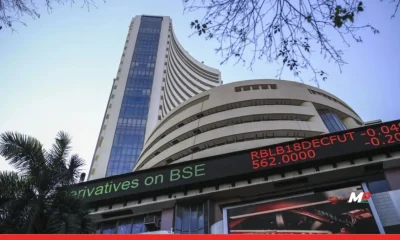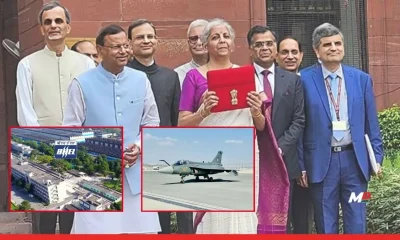Business
Key highlights from the Union Budget 2024-25
Published
6 months agoon

The highly anticipated Union Budget 2024-25 was presented by Finance Minister Nirmala Sitharaman, with everyone curious to see what lies in store for them and the nation. From tax tweaks to infrastructure overhauls, this budget is packed with details that are sure to have everyone buzzing. Let’s dive into all the big stories you need to know.
India’s economic resilience shines bright
According to the Finance Minister, India’s economic growth continues to be the “shining exception” and will remain so in the years ahead. Despite the global economy facing policy uncertainties and significant downside risks, India has demonstrated remarkable resilience in the face of global shocks. Sitharaman proudly proclaimed that India will remain the economic powerhouse, defying the gloomy predictions and proving that we’re a force to be reckoned with.
Nine priorities for the Nation
The FM laid out nine key priorities for this year and the years to come. From boosting productivity and resilience in agriculture to ensuring inclusive human resource development and social justice, this budget is aiming to touch every aspect of our lives. But the real showstopper is the focus on job creation and skilling, which is sure to give the youth of our nation some cause for celebration.
Income Tax tweaks: Nothing for the Middle Class (again)
The last time India saw a major Income Tax rejig was a decade ago, and while the Finance Minister did tinker with the income tax regime, it was largely an eyewash, with nothing for the middle class to celebrate.
The new tax regime saw some major changes, including an increase in the standard deduction to ₹75,000 and a revised tax rate structure. While salaried individuals may have been hoping for more, the FM did promise that those in the new tax regime could save up to an eye-watering ₹17,500 in income tax.
If you’re looking to make money via the markets, there’s news for you too. There are changes to capital gains tax as well; long-term gains will now be taxed at 12.5%, while short-term gains have seen a hike to 20%. Looks like the stock market traders better start practicing their best poker faces.
A blow to F&O traders
Speaking of the stock market, the Finance Minister had a little surprise up her sleeve for the Futures and Options (F&O) traders. She announced a significant increase in the Securities Transaction Tax (STT) rate, from 0.01% to 0.02%. That’s going to sting a bit, as seen by initial reactions from the bourses, which nosedived on the news.
Angel Tax takes a backseat
But it’s not all doom and gloom for the startup community. The Finance Minister delivered a bit of good news by announcing the abolition of the dreaded angel tax. This move is sure to provide a much-needed boost to the entrepreneurial spirit of our nation, as budding innovators can now breathe a sigh of relief.
Steady on the Capex front
While there may have been more than a little disappointment for the salaried class, the government has retained its commitment to capital expenditure, allocating a whopping ₹11.11 lakh crore for FY25. That figure represents 3.4% of India’s GDP. This is largely in line with the government’s track record of being committed to building out infra across the length and breadth of the nation.
Customs Duty shake-up
The budget also saw some changes in the customs duty landscape. The FM proposed reducing the Basic Customs Duty (BCD) on mobile phones, mobile PCDA, and mobile charges to 15%. Meanwhile, the duty on gold, silver, and platinum also got a trim, down to 6% and 6.4%, respectively. There’s something for the telecom industry too; they’re slapping a 10-15% increase on printed circuit board assemblies for specific telecom equipment.
Empowering the MSME sector
The FM didn’t forget about the small and medium enterprises (MSMEs), often the backbone of national growth. She announced a slew of measures to support this crucial segment of our economy. A new scheme will facilitate term loans for MSMEs to purchase machinery and equipment without the need for collateral. And to top it off, a ₹100 crore guarantee fund will be introduced to provide credit guarantees for manufacturing MSMEs. Looks like the little guys are getting some big-time love.
Revving up the Agricultural engine
The government has also set its sights on the agricultural sector, with a whopping ₹1.52 lakh crore allocation. But that’s not all – there’s also planning a comprehensive review of agricultural research to improve productivity and develop climate-resilient crop varieties planned. What’s more, the budget will introduce 1 crore farmers to natural farming over the next two years. Looks like our farmers are about to get a whole lot greener (and I’m not just talking about the cash).
Investing in infrastructure and innovation
The budget is also packed with some serious infrastructure love. An additional ₹26,000 crore will be allocated to road connectivity projects, and the government is even setting up a mission for recycling critical minerals and overseas acquisitions. Furthermore, a venture capital fund of ₹1,000 crore will be established to support the space economy, which the FM says will be expanded by five times over the next decade. Houston, we have liftoff!
Affordable Housing takes center stage
The housing sector has something to look forward to too. The government is set to invest a whopping ₹10 lakh crore to address the housing needs of 1 crore urban poor and middle-class families. But that’s not all – the PM Surya Ghar Muft Bijli Yojana will install rooftop solar panels for a staggering 1 crore households. Looks like a bright future on that front.
Supporting states, or appeasement politics?
The budget also had some love for Andhra Pradesh and Bihar, vital partners in the NDA coalition. The FM announced that the government will expedite the Bihar government’s request for external assistance from multilateral development banks. And not to be outdone, Andhra Pradesh will receive a cool ₹15,000 crore, with additional amounts in future years to support the Pollavaram irrigation project and other capital investments.
A special word for the always ignored Middle Class
Just 2.24 crore Indians or 1.6% of India’s population paid tax, including income tax and corporate tax, in 2022-23, as per government data as of 2023. And with individual income tax surpassing corporate taxes in 2022-2023, the middle class is paying more than its fair share of taxes.
And yet, it is a neglected segment, paying that pays through the nose by way of direct and indirect taxation. You can expect to pay approx. 33% by way of direct taxes if you fall in India’s highest tax slab. For good measure, pile on another 20% or so by way of indirect taxes, and it becomes clear; India’s taxation regime is one of the most oppressive in the world.
At this point some might be quick to argue that India has a miniscule tax-paying base compared to other developed countries. France sees 78.3% of its populace cough up their share of taxes, with the USA (50.1%), Germany (61.3%), and UK (59.7%) boasting strong collection figures as well. But the Indian taxpayer gets little for their rupee, be it by way of poor social security nets, perpetually underdeveloped and questionable infra, or even education for our young population.
The marginal increase in tax slabs leaves the personal taxpayer bearing a worrisome burden, with little for them to celebrate in this Union Budget as well, as it has been in years gone by.
Conclusion
From tax tweaks to infrastructure overhauls, it’s clear that the powers that be are leaving no stone unturned. But with a mixed bag on show from the FM, it seems that the status quo is maintained, with little respite for the middle class, increased taxation on investments, and a few states prioritised to the near exclusion of others. Only time will tell if this narrowly focused Budget pays off for the nation.
You may like
-


Driving Digital Change: The 33rd Digital Transformation Summit to Shape India’s $1 Trillion Digital Market
-


Indian Stock Market Crashes: Weak Rupee, Budget Woes, and US Jobs Data Shake Investor Confidence
-


CXO Moves: Major Executive Appointments You Need to Know
-


India’s Silent Housing Crisis: A Real Estate Boom That Leaves Millions Behind
-


HAL’s LCA Tejas to Make Its Debut at Aero India 2025 as Defence Sector Gears Up for Expansion
-


C-Suite Conversations, with Bert Mueller, Founder of California Burrito


